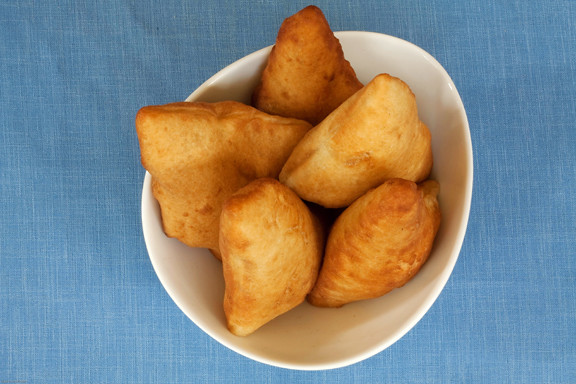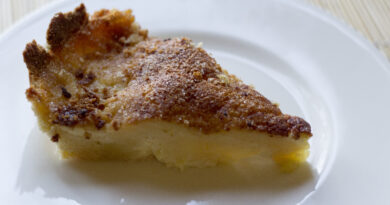Mandazi
Embracing the Flavors of East Africa: Exploring the Delightful World of Mandazi
Introduction: In the vibrant tapestry of African cuisine, there are certain dishes that captivate the senses and evoke a sense of nostalgia. One such culinary delight is Mandazi, a beloved pastry that hails from East Africa. With its golden exterior, soft interior, and subtle sweetness, Mandazi has become a cherished staple in the region, enjoyed as a breakfast treat, snack, or accompaniment to tea. Join me on a delightful journey as we uncover the origins, ingredients, preparation methods, and cultural significance of this iconic East African delicacy.
Origins and Cultural Significance: Mandazi holds a special place in the hearts and homes of people across East Africa, where it is known by various names such as Mahamri in Kenya, Kaimati in Tanzania, and Maandazi in Uganda. The origins of Mandazi can be traced back centuries, with its roots deeply intertwined with the Swahili coastal culture of East Africa. It is believed that Mandazi was introduced to the region by Arab traders, who brought with them the culinary tradition of fried dough pastries.
Over time, Mandazi has evolved to reflect the diverse cultures and culinary influences of East Africa, incorporating local ingredients and flavors into its preparation. Today, it is a ubiquitous presence in homes, markets, and street food stalls across the region, where it is enjoyed by people of all ages as a delicious and satisfying snack.
Ingredients: The beauty of Mandazi lies in its simplicity, with just a few basic ingredients coming together to create a pastry that is both comforting and flavorful. The key components typically include:
- Flour: All-purpose flour serves as the base of the dough, providing structure and texture to the pastry.
- Sugar: Granulated sugar adds sweetness to the dough, balancing out the flavors and contributing to its golden color when fried.
- Baking Powder: Baking powder acts as a leavening agent, helping the dough to rise and become light and fluffy.
- Coconut Milk: Coconut milk is used to moisten the dough, adding richness and a subtle coconut flavor.
- Eggs: Eggs are added to the dough to bind the ingredients together and create a tender texture.
- Spices: Ground spices such as cardamom, cinnamon, or nutmeg are often added to the dough to enhance its flavor and aroma.
- Salt: A pinch of salt is added to the dough to balance the sweetness and enhance the overall flavor profile.
- Oil for frying: Vegetable oil or coconut oil is used for frying the Mandazi until golden brown and crispy.
Preparation: The preparation of Mandazi is relatively simple, making it accessible to home cooks and professional chefs alike. The general method involves the following steps:
- Mixing the Dough: The dry ingredients (flour, sugar, baking powder, spices, and salt) are combined in a large mixing bowl, while the wet ingredients (coconut milk and eggs) are mixed separately. The wet ingredients are then added to the dry ingredients, and the mixture is kneaded until a smooth and elastic dough forms.
- Resting the Dough: The dough is covered and allowed to rest for about 30 minutes to 1 hour, allowing the flavors to meld together and the dough to relax.
- Shaping the Mandazi: Once rested, the dough is divided into small portions and rolled out into circles or squares, about 1/4 to 1/2 inch thick. The shapes can vary depending on personal preference and regional traditions.
- Frying: The shaped Mandazi are fried in hot oil until golden brown and crispy on both sides, flipping halfway through cooking to ensure even browning.
- Draining and Serving: Once fried, the Mandazi are removed from the oil and drained on paper towels to remove excess oil. They can be served warm or at room temperature, dusted with powdered sugar or served with a dipping sauce such as coconut chutney or sweetened condensed milk.
Variations and Regional Influences: While the basic recipe for Mandazi remains fairly consistent across East Africa, there are variations and regional influences that can be found in different countries and communities. In some regions, for example, Mandazi may be flavored with grated coconut, orange zest, or mashed bananas for added sweetness and complexity. Some recipes may also include ingredients such as sesame seeds, raisins, or chopped nuts for texture and flavor.
In addition to variations in flavor, Mandazi can also vary in shape and size, with some regions favoring small, bite-sized pieces while others prefer larger, more substantial pastries. The cooking method may also differ, with some recipes calling for deep frying while others opt for shallow frying or baking.
Health Benefits and Nutritional Value: While Mandazi is undeniably indulgent and should be enjoyed in moderation, it does offer some nutritional value thanks to its wholesome ingredients. Coconut milk provides healthy fats and medium-chain triglycerides (MCTs), which can support heart health and boost metabolism. Eggs are a good source of protein, vitamins, and minerals, while spices such as cinnamon and nutmeg offer antioxidant properties and potential health benefits.
When enjoyed as part of a balanced diet, Mandazi can be a delicious and satisfying treat that nourishes both the body and the soul, providing energy, comfort, and a taste of East African culture.
Conclusion: In a world filled with an abundance of culinary delights, Mandazi stands out as a cherished symbol of East African hospitality, tradition, and community. Its simple yet flavorful ingredients, easy preparation, and versatility make it a beloved treat that has stood the test of time. Whether enjoyed as a breakfast pastry, afternoon snack, or dessert, Mandazi invites us to slow down, savor the moment, and celebrate the rich and diverse flavors of East African cuisine. As we bite into its golden exterior and soft, pillowy interior, we are transported to the vibrant streets of Nairobi, Dar es Salaam, or Kampala, where the scent of spices and the sound of laughter fill the air. With each delicious bite, we are reminded of the power of food to bring people together, bridge cultures, and create lasting memories.



